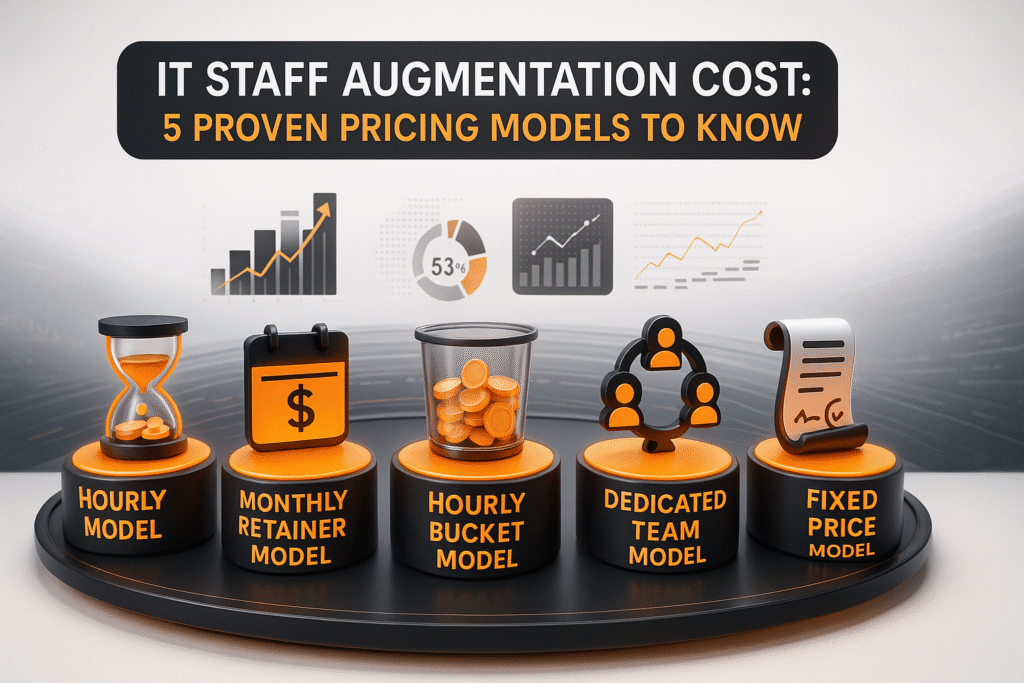Understanding the true IT staff augmentation cost is vital for startup owners, business leaders, and IT managers aiming to scale their technology teams efficiently. Many companies confront challenges like unexpected pricing, hidden overheads, or unclear pricing models that make budgeting difficult. This comprehensive guide explores five proven pricing models for IT staff augmentation, clarifies their benefits, and offers insights on selecting the optimal approach to fit your unique needs. By grasping these pricing structures, you can improve project outcomes, reduce surprises, and better control your IT staffing budget.
What Is IT Staff Augmentation?
IT staff augmentation is a strategic approach that allows businesses to supplement their internal teams with external IT professionals temporarily. Instead of full-time hiring, organizations can bring in specialists such as developers, designers, or project managers as needed for specific projects or tasks. This model offers scalability, flexibility, and access to diverse technical expertise without the long-term commitment of permanent employees.
Startups and small businesses benefit from staff augmentation by gaining agility and controlling costs, while large organizations often leverage it for rapid scaling and specialized skills acquisition. For example, an early-stage startup building an MVP might augment their internal team with a couple of experienced PHP developers from RSquare Technologies to accelerate delivery without the overhead of full-time salaries.
Why Understanding IT Staff Augmentation Cost Matters
Comprehensively understanding IT staff augmentation cost is essential for effective project budgeting and resource planning. Many businesses fall victim to hidden fees, fluctuating hourly rates, or unclear scope definitions, which result in budget overruns and project delays.
Clarity in pricing helps stakeholders make informed decisions, allocate appropriate funds, and set realistic expectations with vendors. Moreover, transparent cost insights enable businesses to evaluate the return on investment (ROI) and optimize their staffing strategies. Failure to account for all cost factors—including management fees, onboarding, and potential scope creep—can jeopardize the project’s success and strain organizational resources. Using cost calculators like the one available at Tech IT Staff Augmentation Cost Calculator can provide a clearer picture, allowing you to forecast expenses accurately and avoid surprises.
5 Proven Pricing Models to Know
Hourly Model
The hourly pricing model charges you based on the actual hours your IT professionals work on your projects. It offers maximum flexibility, making it ideal for short-term projects, ad-hoc tasks, or evolving requirements where the scope isn’t fully defined. You only pay for the actual time spent, which allows fine control over your budget.
Pros:
-
Pay strictly for hours worked
-
Easily scale the team up or down
-
Best for tasks requiring specific skills on demand
Cons:
-
Requires strict time tracking to avoid overruns
-
Final cost can be unpredictable with changing project scope
Monthly Retainer Model
This model involves paying a fixed monthly fee for continuous access to IT staff dedicated to your project. It’s suitable for ongoing development needs, especially for startups and SMBs scaling digital products. The predictable monthly budget helps optimize financial planning and resource allocation.
Pros:
-
Predictable monthly expense
-
Dedicated resources focused solely on your project
-
Easier long-term planning and collaboration
Cons:
-
Requires commitment for a contract period
-
May incur costs for unused time if workload fluctuates
Hourly Bucket Model
In this option, you pre-purchase a block of working hours (e.g., 100 or 200 hours) that your team can use flexibly throughout the project period. This suits businesses with fluctuating workloads needing the flexibility of the hourly model, but with somewhat controlled spending.
Pros:
-
Flexible use of purchased hours
-
Cost-effective for unpredictable workloads
-
No need to pay monthly if hours are not utilized
Cons:
-
Unused hours may not carry forward depending on vendor terms
-
Requires good management to optimize hour usage
Fixed Price Model
This model provides a lump sum price for a clearly defined project or deliverable with well-established scopes and deadlines. It minimizes the risk of unexpected costs for businesses, making it perfect for projects with fixed requirements such as a specific mobile app or feature set.
Pros:
-
Predictable, upfront budgeting
-
Minimizes financial surprises
-
Best for projects where scope is agreed upon
Cons:
-
Less flexibility to handle scope changes
-
May require detailed upfront planning and project freezes
Dedicated Team Model
Hire a full-time remote team under a monthly contract that fully integrates with your internal staff and workflows. This model is favored by startups and enterprises with large-scale product development needing consistent skills over an extended period.
Pros:
-
High scalability and integration
-
Lower per-hour costs due to continuous engagement
-
Full-time focus on your project ensures faster delivery
Cons:
-
Requires longer commitments
-
Needs strong management coordination

For detailed explanations and a broader view of IT staff augmentation services, you can visit our IT Staff Augmentation Guide.
Factors Affecting IT Staff Augmentation Cost
Understanding the key factors that influence IT staff augmentation cost is crucial for effectively budgeting your projects and selecting the most suitable pricing model. Below are the main elements that impact the overall pricing of staff augmentation:
Skill Level and Experience
The expertise and experience of the IT professionals you hire significantly affect the cost. Junior developers, with 0-2 years of experience, tend to charge lower hourly rates, typically ranging from $10 to $15 per hour. Mid-level developers with 3-5 years of experience generally charge between $20 to $30 per hour. Senior developers and specialized experts, such as in AI, blockchain, cybersecurity, or cloud technologies, command premium rates often exceeding $50 to $150 per hour or more.
While higher hourly rates might appear expensive initially, seasoned developers often deliver projects faster, with better code quality and fewer revisions ultimately reducing your project’s total cost and time to market.
Geographic Location
The region where your staff augmentation provider and developers are based profoundly influences cost. Developers in North America or Western Europe command higher rates due to the higher cost of living and stringent Labor regulations. On the other hand, Eastern Europe, Latin America, and parts of Asia provide highly skilled IT talent at a significantly lower cost without compromising quality, particularly if the vendor has strong screening and management processes.
For example, facilities offered by RSquare Technologies tap into a global talent pool, balancing expertise and cost-effectiveness by leveraging talent from multiple regions. This global access allows startups and SMBs to benefit from lower costs while maintaining access to top tech skills.
Project Duration and Complexity
The length of your project and the complexity of tasks influence staff augmentation costs. Longer projects often benefit from discounted monthly retainer models or dedicated teams, which provide better cost predictability and efficiency. Complex projects requiring niche skills or cutting-edge technological expertise. such as AI-powered applications or enterprise-grade systems usually increase costs due to the involvement of senior specialists and additional resources such as architects and testers. Misjudging project scope or complexity can lead to budget overruns, so it’s advisable to perform a detailed project analysis and cost breakdown upfront.
Vendor Overhead and Additional Services
The total cost of staff augmentation includes not just the developer’s salary but also vendor overheads and value-added services. These may encompass project management, quality assurance, infrastructure support, recruitment, talent retention, and administrative expenses. Vendors with comprehensive service offerings might charge a premium, but their management and quality assurance support can lead to smoother project delivery and better ROI.
Clarity on what your vendor includes in their pricing avoids surprises and helps you gauge the true IT staff augmentation cost. Vendors like RSquare Technologies emphasize transparent pricing, ensuring all overheads and fees are upfront so businesses can plan accordingly.
How to Choose the Right IT Staff Augmentation Services
Aligning your business goals with an appropriate pricing model maximizes IT staff augmentation cost efficiency.
-
Startups and SMBs with fluctuating needs may prefer the hourly or hourly bucket models for maximum flexibility.
-
Organizations with steady development projects benefit from monthly retainer or dedicated team models for predictable budgeting and team continuity.
-
Evaluate vendors on experience, quality, pricing transparency, and support. RSquare Technologies offers tailored pricing plans, expert developer support, and streamlined billing to help you make optimal choices.
Common Mistakes to Avoid
-
Overestimating project scope leading to inflated budgets.
-
Ignoring hidden costs such as onboarding or tool subscriptions.
-
Selecting vendors solely on lowest price, sacrificing quality.
-
Poor communication causing misunderstandings and rework.
-
Neglecting to clearly define deliverables and timelines.
Real-Life Use Case
A growing e-commerce startup partnered with RSquare Technologies to augment their team with dedicated PHP and front-end developers. By opting for the dedicated team pricing model, they secured predictable monthly costs and fast-tracked their product launch. Continuous collaboration and flexible scaling allowed them to optimize spend, reduce time-to-market, and achieve a 30% boost in development efficiency.
Why Choose RSquare Technologies?
RSquare Technologies offers industry-leading IT staff augmentation services with transparent, competitive pricing models aligned to your unique business objectives. Our flexible engagement options, expert developers, and seamless integration ensure you get unparalleled value and project success. Explore our hire dedicated developers and comprehensive custom software development services to power your growth.
Conclusion and Call to Action
Understanding IT staff augmentation cost empowers you to select a pricing model that fits your budget and accelerates project success. Avoid costly pitfalls by choosing flexible, transparent pricing and a trusted partner like RSquare Technologies. Contact us today at Contact RSquare Technologies to learn how our expert augmentation services can transform your IT capabilities.



